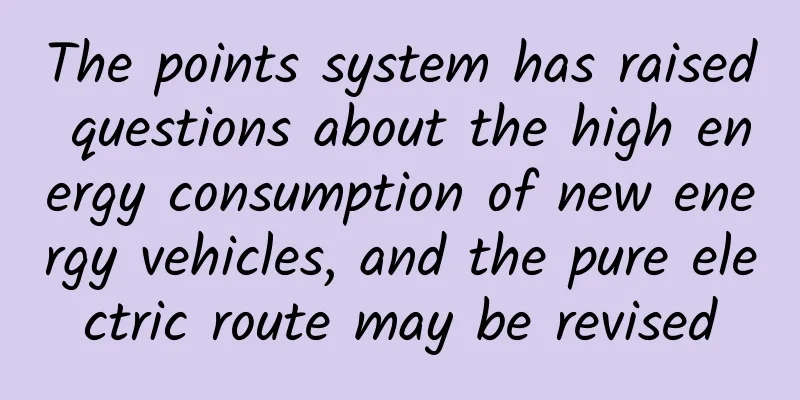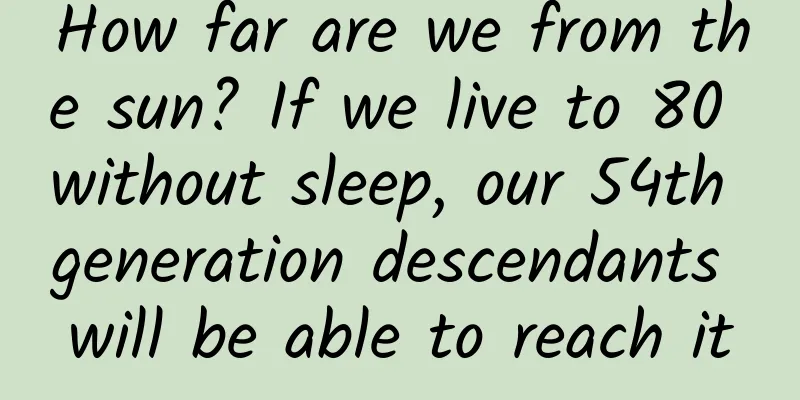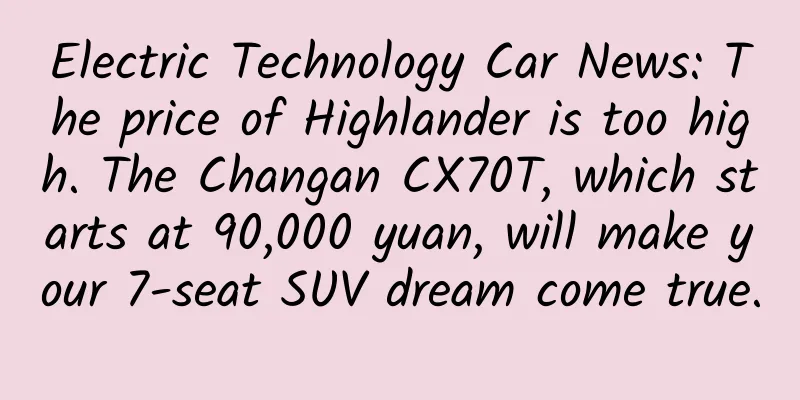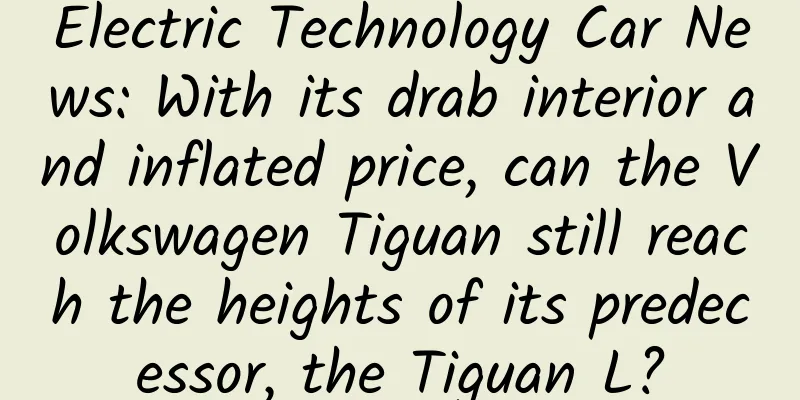The points system has raised questions about the high energy consumption of new energy vehicles, and the pure electric route may be revised

|
After the introduction period and entering the growth period, the development path of new energy vehicles may see adjustments. "First of all, the policy and technical path, pure electric, hybrid or extended range?" Chen Qingquan, an academician of the Chinese Academy of Engineering and founding chairman of the World Electric Vehicle Association, asked this question in his speech at the 2017 Global Lithium Industry International Summit Forum held by the China Electric Vehicle Hundred People's Forum. This is Chen Qingquan's second time to raise this question. In addition to Chen Qingquan, two other Chinese Academy of Engineering academicians studied the development of new energy vehicles around the world in the first half of this year. After combining the characteristics of my country's new energy vehicle development, they proposed that the current new energy vehicle development route needs to be adjusted. Guo Konghui, an academician of the Chinese Academy of Engineering who participated in the release of the national "Energy-Saving and New Energy Vehicle Technology Roadmap" in 2016, wrote in a suggestion earlier this year: "The development of 'standard' electric vehicles vigorously promoted by the state is meaningless to places that lack vehicles, because the electric vehicles encouraged by the state have complex structures, high power consumption, heavy power batteries, and low cost and efficiency." In Guo Konghui's view, current electric vehicles have the problem of high energy consumption. Yang Yusheng, an academician of the Chinese Academy of Engineering who is well-known in the industry for his sharp and outspoken views, made a more detailed and in-depth analysis of this issue. In Yang Yusheng's view, new energy vehicles need a new guiding ideology in the post-subsidy era, and the original focus on developing pure electric vehicles, plug-in hybrid vehicles and fuel cell vehicles is no longer appropriate. "We need to develop pure electric vehicles with emission reduction as the core requirement." Yang Yusheng said, "Pure electric vehicles may have serious emissions. Long-distance and luxury pure electric vehicles must be equipped with more batteries, which leads to high power consumption, and China's electricity mainly comes from coal." The pure electric technology route was established in 2009 and officially released in 2012. After a long period of time and high-level discussions, it was finally decided to focus on the development of pure electric-driven electric vehicles, including electric vehicles, plug-in hybrid vehicles, and fuel cell electric vehicles. In March 2012, the Ministry of Science and Technology's "12th Five-Year Plan for the Development of Electric Vehicles" formally proposed a pure electric-driven technology transformation strategy. Thereafter, in 2014, pure electric drive was industrialized. "In the medium and long term, new requirements must be added to the development route of electric vehicles," said Ouyang Minggao, a professor at Tsinghua University and a member of the National Power Strategy Advisory Committee. He believes that in the long-term development technology roadmap, the development path of electric vehicles must add three new requirements, namely "low-carbon energy, ecological manufacturing, and networking", to the previously proposed requirements of "electrification, lightweight, and intelligence". Concerns about the new energy vehicle points system The reason for proposing the new "six transformations" is that electric vehicles are not completely clean. "Electric vehicles have zero emissions during driving, but there are emissions during the power generation process, including carbon dioxide and toxic gases such as PM2.5. Simply saying that electric vehicles are clean is not convincing, and data is needed," said Wang Binggang, leader of the National 863 "Energy Saving and New Energy Vehicles" Major Project Supervision and Consulting Expert Group. Since the source of energy used is not clean, this has led to loopholes in the new energy vehicle credit system to be implemented next year. "Tesla can earn hundreds of millions of dollars in the United States every year by selling credits to make up for the company's losses, but in Singapore it has to be punished for high power consumption (i.e. high emissions)," said Yang Yusheng. At present, my country's new energy credit system is basically linked to California, the United States. California's credits are linked to pure electric mileage. Simply put, California's zero-emission vehicle credits = 0.5 + 0.01 × pure electric miles, while some zero-emission models' credits = 0.3 + 0.01 × pure electric miles. Tesla-S can get up to four points. "This formulation is imperfect and may lead to encouraging the development of high-emission vehicles," Yang Yusheng pointed out. In fact, the pursuit of high mileage for electric vehicles has become the main trend of current development. Electric vehicles with a range of 500 kilometers or even more have this tendency. In 2016, when the Ministry of Industry and Information Technology first proposed the algorithm for the new energy credit system, it basically copied the California credit scoring method, except that the calculation of miles was changed to kilometers. "Electric vehicles themselves do not reduce emissions, and the vehicles that buy credits from them cannot reduce emissions, which goes against the government's purpose of reducing emissions," Yang Yusheng said. Academician Yang Yusheng proposed a new calculation method. He suggested that reducing electricity consumption and reducing CO2 emissions should be linked to credits, and long-range pure electric vehicles should not be encouraged. The credit method for new energy vehicles should also be changed to fuel-saving credits + emission reduction credits. Among them, fuel-saving credits can refer to the California model, 0.5 for pure electric vehicles and 0.3 for plug-in vehicles. Emission reduction credits are calculated based on the emission reduction compared with fuel vehicle emissions. Coincidentally, Wang Binggang also proposed a similar calculation rule recently. Wang Binggang suggested that my country learn from Singapore's approach. The Singapore government has a "carbon emission factor" index in its regulations. By calculating the electricity emission factor (carbon emissions caused by each kilowatt-hour of electricity) and the fuel emission factor (carbon emissions caused by each liter of fuel), these two emission factors are used to estimate the carbon emissions per kilometer for each vehicle model. "We must publish authoritative data on carbon emission factors based on our own situation, update them regularly, and provide national and regional averages," said Wang Binggang. Although the two methods are different, the root cause points to the same place - the current new energy vehicle points system has loopholes in the method, which may lead to deviations in the development of new energy vehicles in my country aimed at energy conservation and emission reduction, or even counterproductive. "Our policy should encourage low-power consumption products and prevent the tendency of unilaterally emphasizing long mileage without considering consumption," said Wang Binggang. Are there any other loopholes to exploit? This year, the new energy vehicle credit system has been slightly adjusted. On June 13, the State Council Legislative Affairs Office issued the "Measures for the Parallel Management of Passenger Vehicle Enterprise Average Fuel Consumption and New Energy Vehicle Credits (Draft for Comments)" drafted by the Ministry of Industry and Information Technology, but the above-mentioned electric vehicle emission problem has not been solved. However, as a high-probability event, this policy will face new adjustments in the future as the country's energy conservation and emission reduction tasks increase. Regarding energy conservation and emission reduction of electric vehicles, Ouyang Minggao, a member of the national electric vehicle plan think tank, suggested adding "three changes" to the technical route, namely, electrification should be combined with low-carbon energy, lightweight and ecological manufacturing, and intelligence should be combined with networking. In detail, the energy source of electric vehicles should be clean, including the advancement of battery technology. In manufacturing, the entire production process should also be clean, especially the improvement of production technology, which should be further improved on the standards of fuel vehicles; in addition, intelligence should be combined with networking. Wang Binggang believes that power companies play an extremely important role in this transformation process. On the one hand, the source of electricity should be transformed into cleaner production methods, such as developing hydropower, wind power, nuclear power, etc., gradually reducing the supply of coal-fired power, reducing emissions from the source, and saving energy. Secondly, the supply can appropriately provide special support for new energy vehicles. "Since most electric vehicles are charged at night, they take advantage of the low period of the power grid. We should encourage business models to change in this regard, and power companies should also provide support." Wang Binggang said. However, there is a fatal loophole in the new energy automobile credit system. In the credit system, credits mainly come from production and the mileage of the product itself, which means that more production can earn more credits. Although the price and trading mechanism of credits have not yet appeared in the latest draft for comments, the requirements for car companies are very clear. From 2018 to 2020, the proportion of new energy automobile credits in the sales vehicles of passenger car companies is required to be 8%, 10%, and 12% respectively. This means that credits will be a hot resource in the future. For example, Volkswagen of Germany, in the face of pressure to meet the standards, has repeatedly called on the Chinese government to delay the implementation of the points system and called for changes to some of its terms. Since my country's new energy vehicle points system mainly refers to the "Zero Emission Vehicle (ZEV) Program" points system in California, we can roughly estimate the value of a point. In California, companies that fail to meet the standards in the year can purchase points from companies with surplus points, make up the points within two years to comply with the regulations, or pay a fine of $5,000 for each point. Compliant companies can either sell surplus points for profit or store them for future use. If equivalently converted, China's penalty for violation of points may be around 5,000 yuan to 40,000 yuan, and the price of new energy points should be slightly lower than the fine amount. This is a great fortune for the company. Recently, a senior executive of a new car company did not shy away from expressing his desire for this, saying that new energy vehicle credits will become part of the company's revenue in the future. For policymakers, how to avoid a new round of vicious transactions caused by the credit system is also a difficult question to answer. As a winner of Toutiao's Qingyun Plan and Baijiahao's Bai+ Plan, the 2019 Baidu Digital Author of the Year, the Baijiahao's Most Popular Author in the Technology Field, the 2019 Sogou Technology and Culture Author, and the 2021 Baijiahao Quarterly Influential Creator, he has won many awards, including the 2013 Sohu Best Industry Media Person, the 2015 China New Media Entrepreneurship Competition Beijing Third Place, the 2015 Guangmang Experience Award, the 2015 China New Media Entrepreneurship Competition Finals Third Place, and the 2018 Baidu Dynamic Annual Powerful Celebrity. |
<<: Mitsubishi leverages Renault and Nissan's resources to expand into the U.S. and Chinese markets
>>: Is LCD blue light harmful, but OLED blue light is harmless? Who is fooling users?
Recommend
Xiaohongshu’s corporate promotion strategy!
Recently, especially in the past one or two years...
If you eat a piece of chocolate while chewing gum, will the gum disappear?
When you are not hungry but always want to chew s...
Southeast Asian cross-border e-commerce platform Shopee Entrepreneurship Course
Southeast Asian cross-border e-commerce platform ...
A complete guide to starting a new Tik Tok account!
1. Background The development of technology is th...
The CTO behind a technical team of 1,000 people: CTO training is far more than technical training
[51CTO.com original article] While most technical...
Starting a business? Actually, I just don’t want to work.
[[155807]] Beijing seemed to be in a state of obs...
Is Papi Jiang really hard to replicate?
The short video industry started to boom in 2016....
Double 12 excellent brand promotion cases are here
For operations partners, the activities at the en...
This is the most common model of user operation. Come and take a look. It is written in great detail!
As an operator , you must have done this: invite ...
American TV series enter the era of strict inspection ahead of time, and cloud storage becomes the biggest beneficiary
On February 27, the eighth day of the first lunar...
Wandering around old Tokyo with Japanese literary giants
Introduction In this book, we invited Nagai Kafu,...
New vulnerability turns Android phones into trees?
Trend Micro reported a vulnerability that was mar...
Samsung designer explains S5 design concept: plastic shell feels better
Although Samsung is now the world's number on...
One move to win? Can the curved screen Note Edge save Samsung?
Compared to ordinary users' expectations for ...
How to operate private domain traffic community?
Many people who want to start private domain comm...









